University Research Plan: Australian Accounting Standard Development
VerifiedAdded on 2023/01/11
|6
|1165
|87
Report
AI Summary
This report outlines a research plan centered on accounting standards, specifically focusing on the Australian context. The introduction defines accounting standards and their importance in financial reporting, highlighting the role of the Australian Accounting Standards Board (AASB). The literature review synthesizes existing research, including works by Karen Handley, Professor James Guthrie, Christine Helliar, Tim Austin, Natasja Steenkamp, Emily Fox, and Nicholas Pawsey, exploring topics such as reduced disclosure requirements, international harmonization, the impact on charities, and the effects of specific standards like AASB 138 and IAS 36. The methodology adopts a qualitative approach, utilizing secondary data from credible sources like government websites and published journals. The report aims to provide a comprehensive overview of the research approach and the relevant literature surrounding accounting standards, facilitating a deeper understanding of their development and impact.

Running head: Development of Research Plan
Development of Research Plan
Name of the Student
Name of the University
Author Note
Development of Research Plan
Name of the Student
Name of the University
Author Note
Paraphrase This Document
Need a fresh take? Get an instant paraphrase of this document with our AI Paraphraser
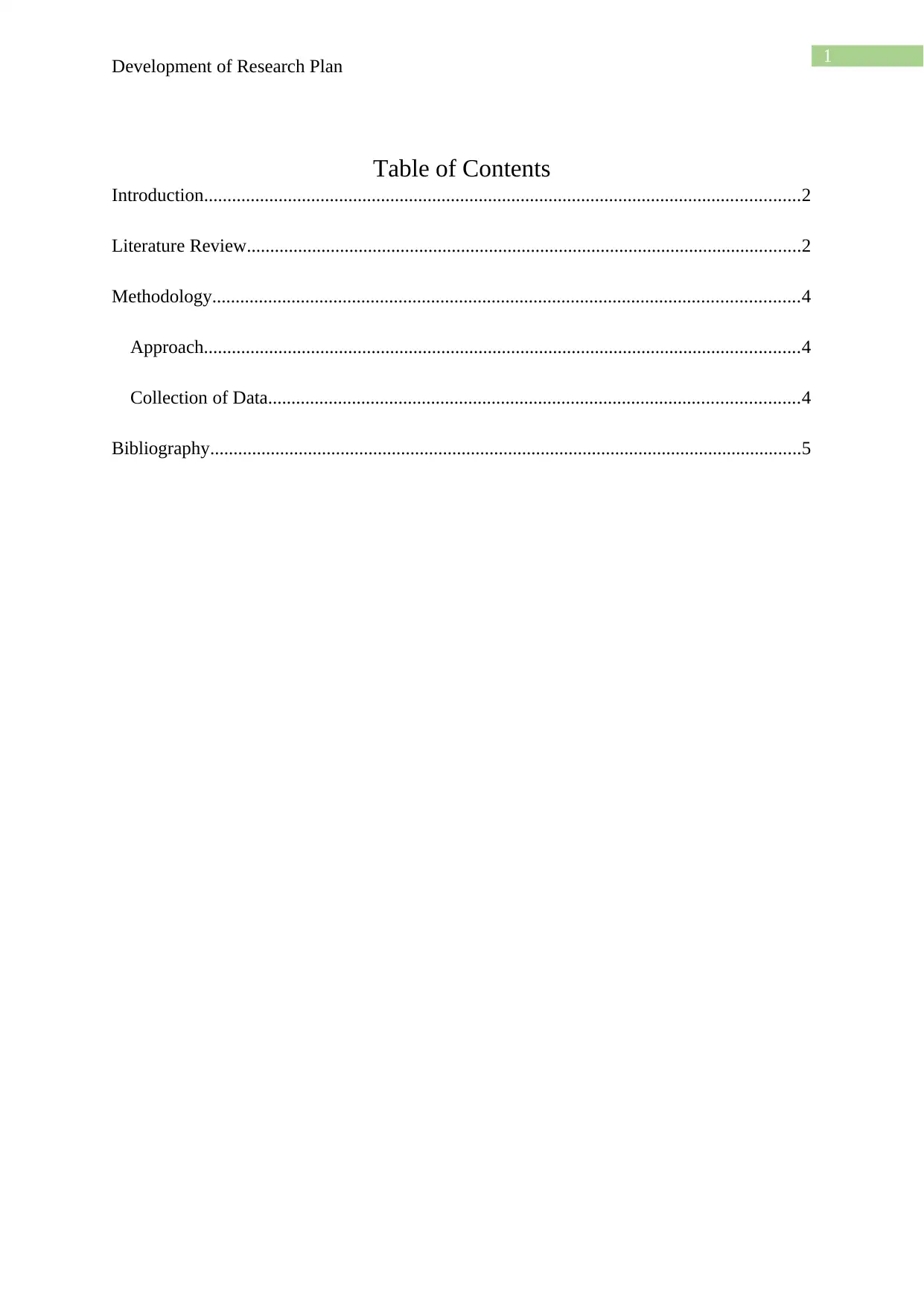
1
Development of Research Plan
Table of Contents
Introduction................................................................................................................................2
Literature Review.......................................................................................................................2
Methodology..............................................................................................................................4
Approach................................................................................................................................4
Collection of Data..................................................................................................................4
Bibliography...............................................................................................................................5
Development of Research Plan
Table of Contents
Introduction................................................................................................................................2
Literature Review.......................................................................................................................2
Methodology..............................................................................................................................4
Approach................................................................................................................................4
Collection of Data..................................................................................................................4
Bibliography...............................................................................................................................5
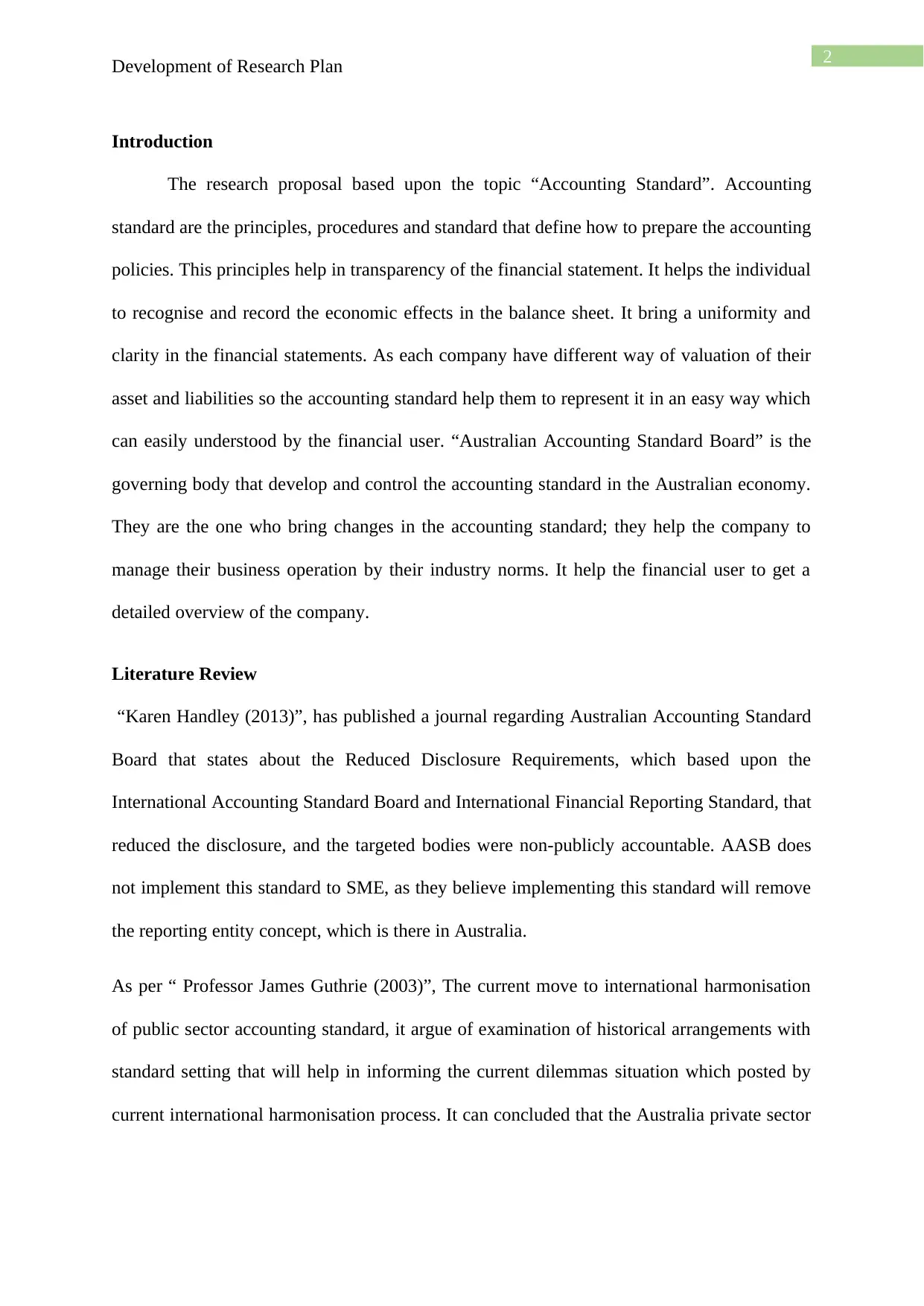
2
Development of Research Plan
Introduction
The research proposal based upon the topic “Accounting Standard”. Accounting
standard are the principles, procedures and standard that define how to prepare the accounting
policies. This principles help in transparency of the financial statement. It helps the individual
to recognise and record the economic effects in the balance sheet. It bring a uniformity and
clarity in the financial statements. As each company have different way of valuation of their
asset and liabilities so the accounting standard help them to represent it in an easy way which
can easily understood by the financial user. “Australian Accounting Standard Board” is the
governing body that develop and control the accounting standard in the Australian economy.
They are the one who bring changes in the accounting standard; they help the company to
manage their business operation by their industry norms. It help the financial user to get a
detailed overview of the company.
Literature Review
“Karen Handley (2013)”, has published a journal regarding Australian Accounting Standard
Board that states about the Reduced Disclosure Requirements, which based upon the
International Accounting Standard Board and International Financial Reporting Standard, that
reduced the disclosure, and the targeted bodies were non-publicly accountable. AASB does
not implement this standard to SME, as they believe implementing this standard will remove
the reporting entity concept, which is there in Australia.
As per “ Professor James Guthrie (2003)”, The current move to international harmonisation
of public sector accounting standard, it argue of examination of historical arrangements with
standard setting that will help in informing the current dilemmas situation which posted by
current international harmonisation process. It can concluded that the Australia private sector
Development of Research Plan
Introduction
The research proposal based upon the topic “Accounting Standard”. Accounting
standard are the principles, procedures and standard that define how to prepare the accounting
policies. This principles help in transparency of the financial statement. It helps the individual
to recognise and record the economic effects in the balance sheet. It bring a uniformity and
clarity in the financial statements. As each company have different way of valuation of their
asset and liabilities so the accounting standard help them to represent it in an easy way which
can easily understood by the financial user. “Australian Accounting Standard Board” is the
governing body that develop and control the accounting standard in the Australian economy.
They are the one who bring changes in the accounting standard; they help the company to
manage their business operation by their industry norms. It help the financial user to get a
detailed overview of the company.
Literature Review
“Karen Handley (2013)”, has published a journal regarding Australian Accounting Standard
Board that states about the Reduced Disclosure Requirements, which based upon the
International Accounting Standard Board and International Financial Reporting Standard, that
reduced the disclosure, and the targeted bodies were non-publicly accountable. AASB does
not implement this standard to SME, as they believe implementing this standard will remove
the reporting entity concept, which is there in Australia.
As per “ Professor James Guthrie (2003)”, The current move to international harmonisation
of public sector accounting standard, it argue of examination of historical arrangements with
standard setting that will help in informing the current dilemmas situation which posted by
current international harmonisation process. It can concluded that the Australia private sector
⊘ This is a preview!⊘
Do you want full access?
Subscribe today to unlock all pages.

Trusted by 1+ million students worldwide
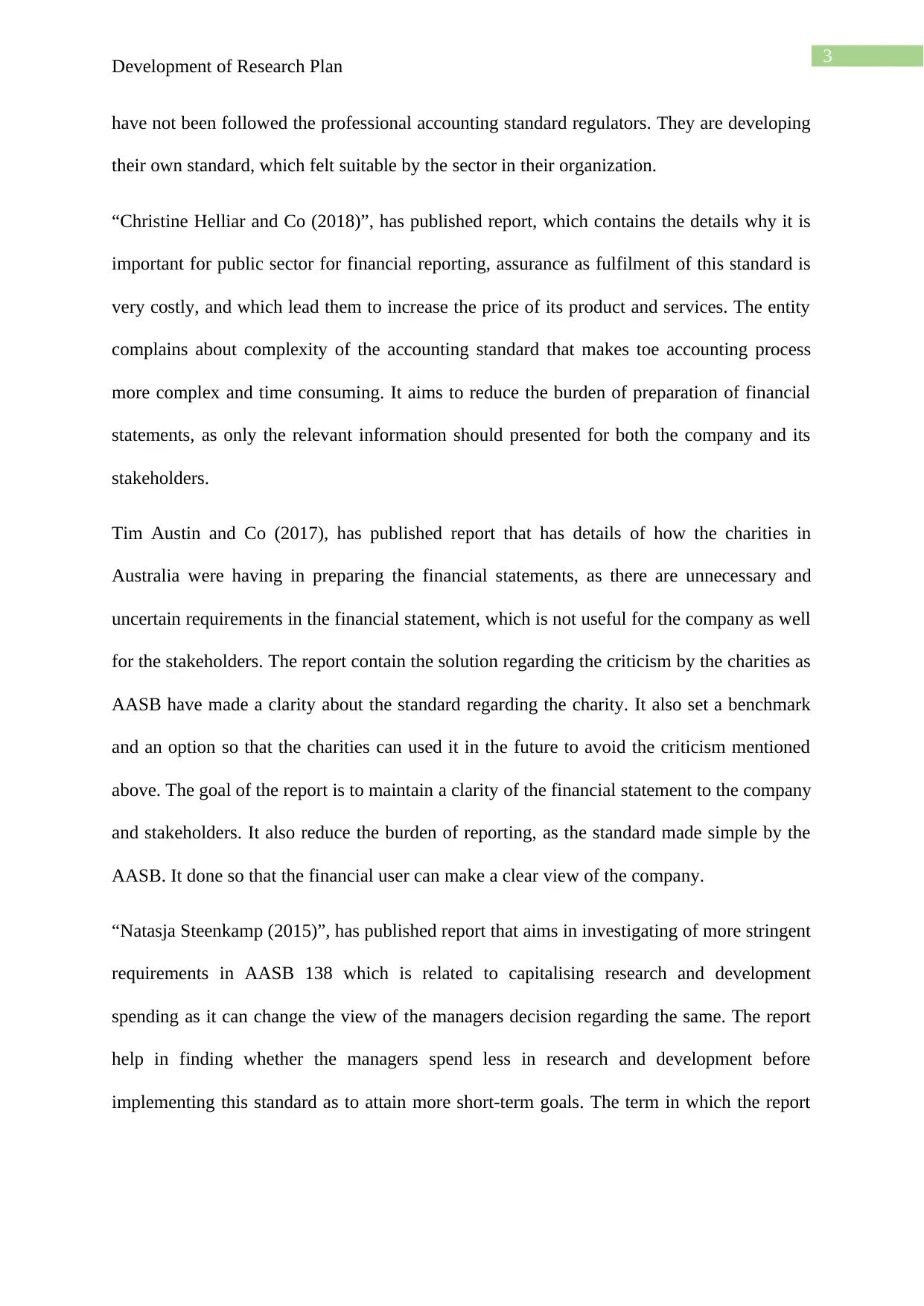
3
Development of Research Plan
have not been followed the professional accounting standard regulators. They are developing
their own standard, which felt suitable by the sector in their organization.
“Christine Helliar and Co (2018)”, has published report, which contains the details why it is
important for public sector for financial reporting, assurance as fulfilment of this standard is
very costly, and which lead them to increase the price of its product and services. The entity
complains about complexity of the accounting standard that makes toe accounting process
more complex and time consuming. It aims to reduce the burden of preparation of financial
statements, as only the relevant information should presented for both the company and its
stakeholders.
Tim Austin and Co (2017), has published report that has details of how the charities in
Australia were having in preparing the financial statements, as there are unnecessary and
uncertain requirements in the financial statement, which is not useful for the company as well
for the stakeholders. The report contain the solution regarding the criticism by the charities as
AASB have made a clarity about the standard regarding the charity. It also set a benchmark
and an option so that the charities can used it in the future to avoid the criticism mentioned
above. The goal of the report is to maintain a clarity of the financial statement to the company
and stakeholders. It also reduce the burden of reporting, as the standard made simple by the
AASB. It done so that the financial user can make a clear view of the company.
“Natasja Steenkamp (2015)”, has published report that aims in investigating of more stringent
requirements in AASB 138 which is related to capitalising research and development
spending as it can change the view of the managers decision regarding the same. The report
help in finding whether the managers spend less in research and development before
implementing this standard as to attain more short-term goals. The term in which the report
Development of Research Plan
have not been followed the professional accounting standard regulators. They are developing
their own standard, which felt suitable by the sector in their organization.
“Christine Helliar and Co (2018)”, has published report, which contains the details why it is
important for public sector for financial reporting, assurance as fulfilment of this standard is
very costly, and which lead them to increase the price of its product and services. The entity
complains about complexity of the accounting standard that makes toe accounting process
more complex and time consuming. It aims to reduce the burden of preparation of financial
statements, as only the relevant information should presented for both the company and its
stakeholders.
Tim Austin and Co (2017), has published report that has details of how the charities in
Australia were having in preparing the financial statements, as there are unnecessary and
uncertain requirements in the financial statement, which is not useful for the company as well
for the stakeholders. The report contain the solution regarding the criticism by the charities as
AASB have made a clarity about the standard regarding the charity. It also set a benchmark
and an option so that the charities can used it in the future to avoid the criticism mentioned
above. The goal of the report is to maintain a clarity of the financial statement to the company
and stakeholders. It also reduce the burden of reporting, as the standard made simple by the
AASB. It done so that the financial user can make a clear view of the company.
“Natasja Steenkamp (2015)”, has published report that aims in investigating of more stringent
requirements in AASB 138 which is related to capitalising research and development
spending as it can change the view of the managers decision regarding the same. The report
help in finding whether the managers spend less in research and development before
implementing this standard as to attain more short-term goals. The term in which the report
Paraphrase This Document
Need a fresh take? Get an instant paraphrase of this document with our AI Paraphraser
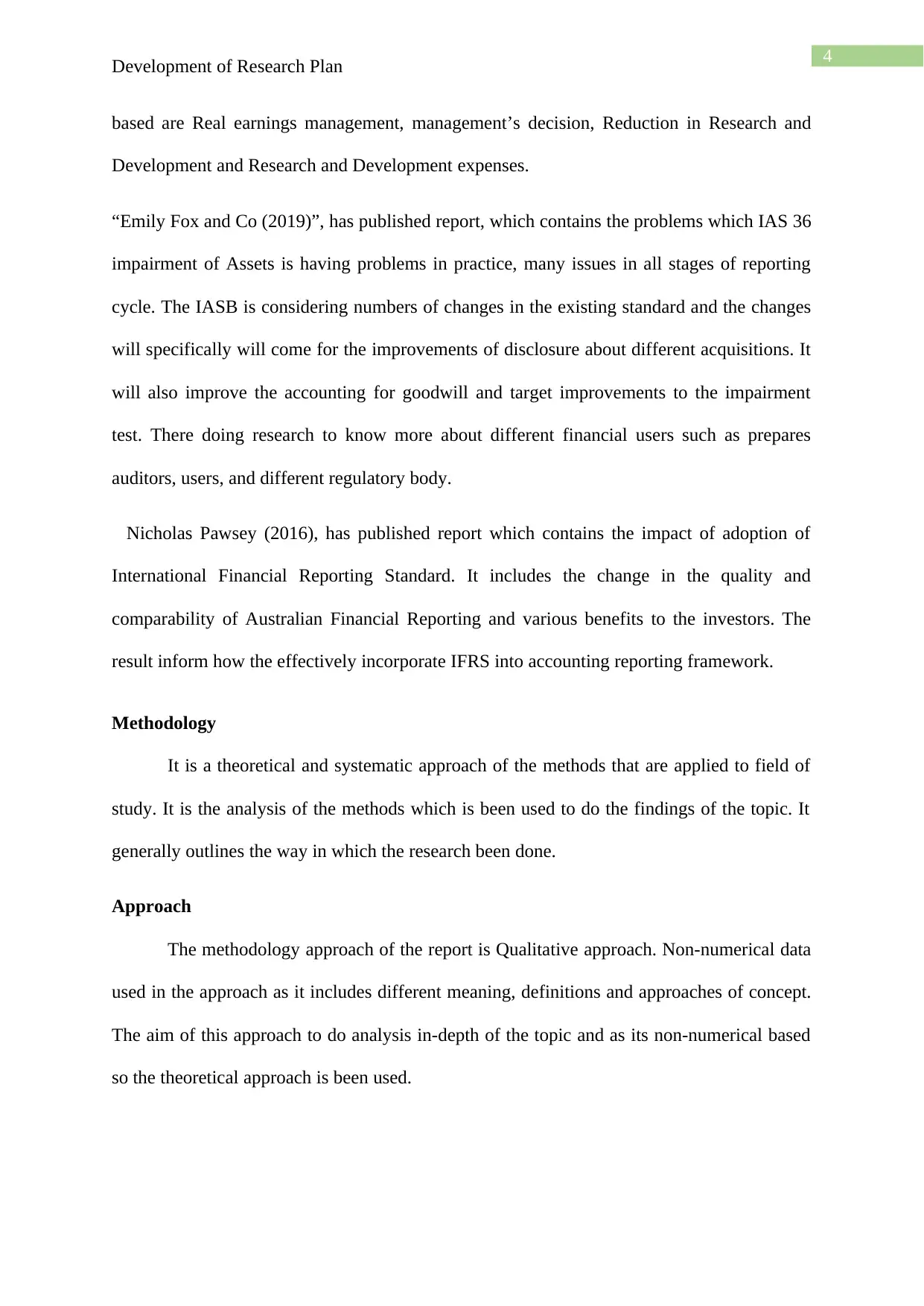
4
Development of Research Plan
based are Real earnings management, management’s decision, Reduction in Research and
Development and Research and Development expenses.
“Emily Fox and Co (2019)”, has published report, which contains the problems which IAS 36
impairment of Assets is having problems in practice, many issues in all stages of reporting
cycle. The IASB is considering numbers of changes in the existing standard and the changes
will specifically will come for the improvements of disclosure about different acquisitions. It
will also improve the accounting for goodwill and target improvements to the impairment
test. There doing research to know more about different financial users such as prepares
auditors, users, and different regulatory body.
Nicholas Pawsey (2016), has published report which contains the impact of adoption of
International Financial Reporting Standard. It includes the change in the quality and
comparability of Australian Financial Reporting and various benefits to the investors. The
result inform how the effectively incorporate IFRS into accounting reporting framework.
Methodology
It is a theoretical and systematic approach of the methods that are applied to field of
study. It is the analysis of the methods which is been used to do the findings of the topic. It
generally outlines the way in which the research been done.
Approach
The methodology approach of the report is Qualitative approach. Non-numerical data
used in the approach as it includes different meaning, definitions and approaches of concept.
The aim of this approach to do analysis in-depth of the topic and as its non-numerical based
so the theoretical approach is been used.
Development of Research Plan
based are Real earnings management, management’s decision, Reduction in Research and
Development and Research and Development expenses.
“Emily Fox and Co (2019)”, has published report, which contains the problems which IAS 36
impairment of Assets is having problems in practice, many issues in all stages of reporting
cycle. The IASB is considering numbers of changes in the existing standard and the changes
will specifically will come for the improvements of disclosure about different acquisitions. It
will also improve the accounting for goodwill and target improvements to the impairment
test. There doing research to know more about different financial users such as prepares
auditors, users, and different regulatory body.
Nicholas Pawsey (2016), has published report which contains the impact of adoption of
International Financial Reporting Standard. It includes the change in the quality and
comparability of Australian Financial Reporting and various benefits to the investors. The
result inform how the effectively incorporate IFRS into accounting reporting framework.
Methodology
It is a theoretical and systematic approach of the methods that are applied to field of
study. It is the analysis of the methods which is been used to do the findings of the topic. It
generally outlines the way in which the research been done.
Approach
The methodology approach of the report is Qualitative approach. Non-numerical data
used in the approach as it includes different meaning, definitions and approaches of concept.
The aim of this approach to do analysis in-depth of the topic and as its non-numerical based
so the theoretical approach is been used.
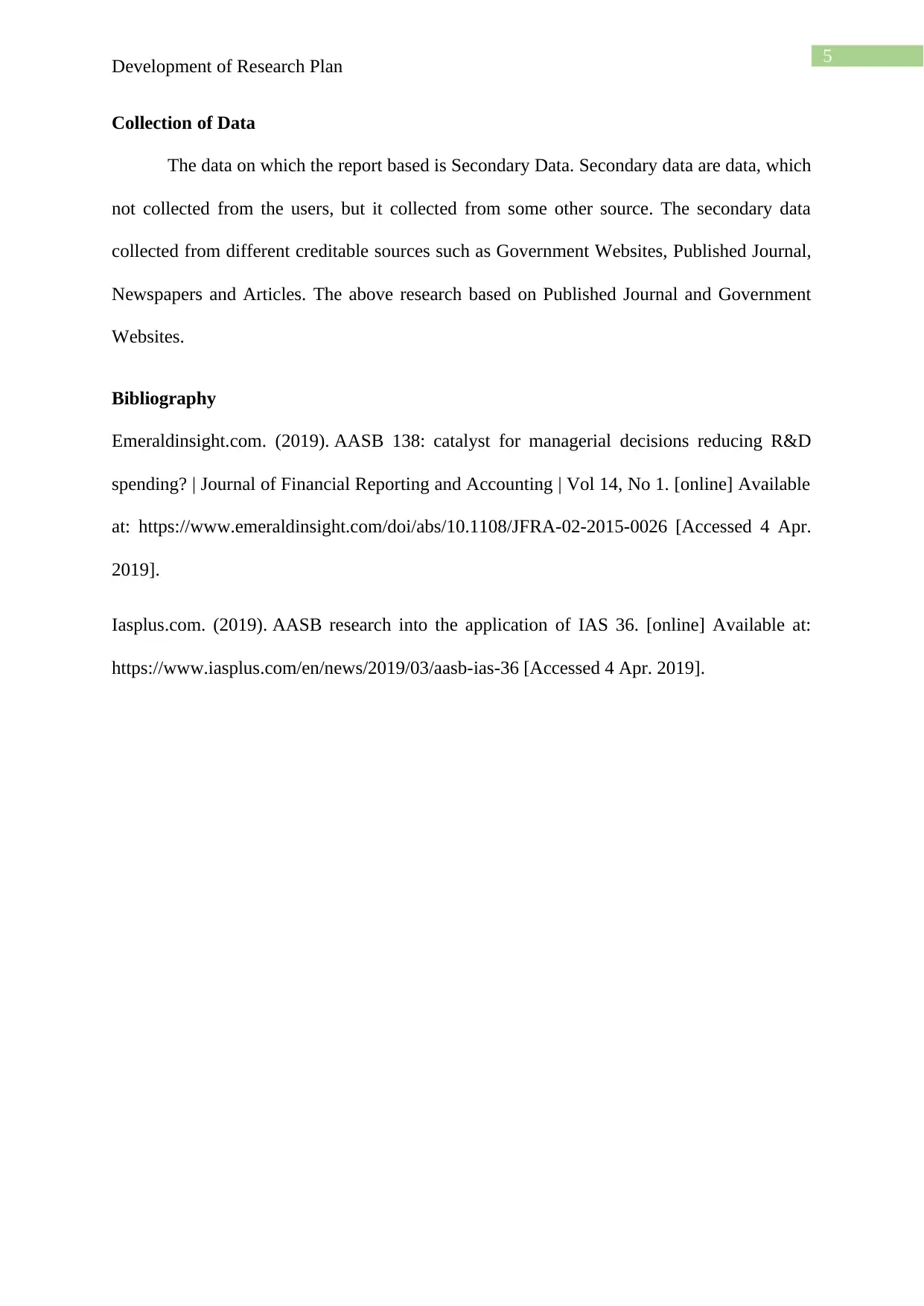
5
Development of Research Plan
Collection of Data
The data on which the report based is Secondary Data. Secondary data are data, which
not collected from the users, but it collected from some other source. The secondary data
collected from different creditable sources such as Government Websites, Published Journal,
Newspapers and Articles. The above research based on Published Journal and Government
Websites.
Bibliography
Emeraldinsight.com. (2019). AASB 138: catalyst for managerial decisions reducing R&D
spending? | Journal of Financial Reporting and Accounting | Vol 14, No 1. [online] Available
at: https://www.emeraldinsight.com/doi/abs/10.1108/JFRA-02-2015-0026 [Accessed 4 Apr.
2019].
Iasplus.com. (2019). AASB research into the application of IAS 36. [online] Available at:
https://www.iasplus.com/en/news/2019/03/aasb-ias-36 [Accessed 4 Apr. 2019].
Development of Research Plan
Collection of Data
The data on which the report based is Secondary Data. Secondary data are data, which
not collected from the users, but it collected from some other source. The secondary data
collected from different creditable sources such as Government Websites, Published Journal,
Newspapers and Articles. The above research based on Published Journal and Government
Websites.
Bibliography
Emeraldinsight.com. (2019). AASB 138: catalyst for managerial decisions reducing R&D
spending? | Journal of Financial Reporting and Accounting | Vol 14, No 1. [online] Available
at: https://www.emeraldinsight.com/doi/abs/10.1108/JFRA-02-2015-0026 [Accessed 4 Apr.
2019].
Iasplus.com. (2019). AASB research into the application of IAS 36. [online] Available at:
https://www.iasplus.com/en/news/2019/03/aasb-ias-36 [Accessed 4 Apr. 2019].
⊘ This is a preview!⊘
Do you want full access?
Subscribe today to unlock all pages.

Trusted by 1+ million students worldwide
1 out of 6
Related Documents
Your All-in-One AI-Powered Toolkit for Academic Success.
+13062052269
info@desklib.com
Available 24*7 on WhatsApp / Email
![[object Object]](/_next/static/media/star-bottom.7253800d.svg)
Unlock your academic potential
Copyright © 2020–2025 A2Z Services. All Rights Reserved. Developed and managed by ZUCOL.





